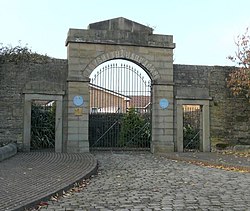| Ladysmith Barracks | |
|---|---|
| Ashton-under-Lyne | |
 Entrance to Ladysmith Barracks | |
| Site information | |
| Type | Barracks |
| Owner | Ministry of Defence |
| Operator | |
| Location | |
| Coordinates | 53°29′54″N2°03′56″W / 53.49839°N 2.06569°W |
| Site history | |
| Built | 1841-1843 |
| Built for | War Office |
| In use | 1843-1958 |
| Garrison information | |
| Occupants | Manchester Regiment |
Ladysmith Barracks was a British military installation on Mossley Road, Ashton-under-Lyne, Greater Manchester.
